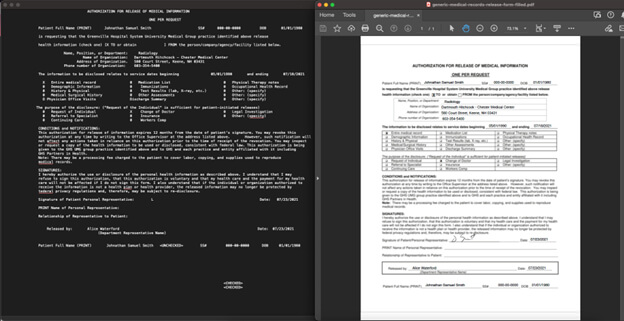In our previous blog post, “Developing Flows using the Hyperscience Flows SDK,” Priya Chakravarthi described the process of leveraging Hyperscience’s Flows SDK to build bespoke Flows (workflows) for the Hyperscience platform. If you haven’t read the post yet, it does a fantastic job of providing background on the Flows SDK and the concept of Flows and Blocks.
In this post, our goal is to inspire developer creativity by providing some real-world examples of what we have built in the Hyperscience platform using the Flows SDK. Since its release, the Flows SDK has become the preferred tool for developing Flows by Hyperscience’s internal engineers due to its ease of use, robust implementations and helper functions, and comprehensive documentation.
Each Flow we discuss in this article was built with the Flows SDK and represents one or more commonly requested features such as data transformation, validation against external systems, cross document validation, and decision automation. While the engineers that completed the work below were internal to Hyperscience, these Flows could have easily been built by partner and customer development teams in-house using the Flows SDK.
CSV Output Generation Flow
We understand that not all systems can ingest JSON formatted data, and while many legacy solutions are enabling the consumption of the format, there are still plenty that rely on delimited files for data transport between systems.
Historically in these situations, Hyperscience customers and partners have been required to solve this data transformation hurdle outside of the Hyperscience application, adding complexity and engineering effort to the overall content processing solution. With the advent of Flows and the Flows SDK, developers now have the ability to transform Hyperscience’s standard JSON output into many other formats before the data leaves the Hyperscience platform.
To help solve this data transformation task in a generic way, Hyperscience Forward Deployed Engineers created a CSV Output Generation Flow. As the name implies, this Flow converts the key/value pairs found in Hyperscience’s JSON into a delimited data structure which can then be accessed via the Hyperscience API.
While CSV output formatting is a common choice, Hyperscience is not limited to either JSON or CSV. Hyperscience can produce other popular data formats such as XML, and as of Release 34, even native Excel worksheets via the use of popular python libraries which can be imported and leveraged in the Hyperscience environment.
The flexibility to transform data directly in the Hyperscience Platform via the Flows SDK ensures that Hyperscience can fit cleanly within existing systems to reduce infrastructure and engineering overhead when implementing a Hyperscience solution.
HCFA Document Processing and Validation Flow
“Trust, but verify” is an old proverb that comes into play when processing user-submitted forms. Both the individuals who fill out forms, and the knowledge workers performing supervision tasks, can and do make mistakes. Fortunately, the Flows SDK makes it possible to verify extracted and supervised data against external data sources and APIs.
To demonstrate this capability, Hyperscience created the HCFA (Health Care Finance Administration) Document Processing and Validation Flow. In this Flow, Hyperscience leverages an external customer database to retrieve records based on a user supplied account number. With this information, Hyperscience is able to ensure that the information submitted on the form matches the information in the existing customer record, or otherwise flag the submission for review. Hyperscience also verifies address information against external API services to ensure downstream systems are provided USPS official versions of addresses.
By being able to leverage external sources of truth, Hyperscience ensures that the data extracted is accurate and enables faster decisioning and actioning than legacy document processing tools.
Live Decisioning Flow
In business, speed is essential. Whether it be insurance or health claims, loan pre-approvals, or other time sensitive decision based activities, the ability to provide feedback quickly to those who need it, can be a major differentiator to your business and a huge contributor to customer satisfaction.
To demonstrate Hyperscience’s ability to provide decisions quickly, and communicate those decisions to end users, Hyperscience’s Sales team in collaboration with the Forward Deployed Engineering team developed the Live Decisioning Flow which was showcased at the 2021 ITC Conference.
During the Live Decisioning demo, information was extracted from two forms that were completed at the booth by Conference attendees: a receipt from a bicycle shop, and an insurance request form for that bicycle. With the Flow, information from the receipt was cross-referenced with information from the insurance form to ensure that the purchase price of the bicycle matched the requested insured value.
By evaluating data points across documents, the Flow was able to make a determination as to whether an insurance policy should be created. This information was then sent downstream for processing and demo recipients received an email response with the results of their policy application within minutes of submitting their forms.
Through the ability to define decisioning logic within Flows, Hyperscience is able to not only extract and verify data, but also act on that data; streamlining the overall business process and delivering impactful decisions quickly.
Submission to .TXT Flow
Born out of a necessity to implement Hyperscience in a “rip-and-replace” scenario, the main goal of the Submission to .TXT Flow was to create a plain text file that matched the layout and spacing of the original PDF submission as closely as possible. The objective was to provide improved accuracy without impacting upstream or downstream systems and processes.
The main problem in this use case was that, while images have an inherit coordinate system via width and height, plain text files do not. How could a Flow replicate the layout and spacing of the submitted PDF without the luxury of specifying location information in the destination file? The answer came from understanding how much horizontal space a “space” character represented, and how much vertical spacing a paragraph break represented.
As part of the data extraction process, Hyperscience provides location information for the left, right, top and bottom edges of each text segment it finds. With this information, Hyperscience Forward Deployed Engineers were able to create a Flow that organized all of the found text segments from top to bottom, and then left to right in order to ensure the text data could be processed in a traditional latin reading style.
Once the text segments were ordered correctly, engineers iterated over them and evaluated gaps between one segment to the next in order to determine how many spaces should fall between them. Similarly, engineers were able to evaluate vertical separation in order to determine where line breaks should be placed.
By writing text segments, spaces, and new line characters to a text file, the Forward Deployed Engineers were able to build a replication of a PDF submission in plain text format with incredible accuracy from an extraction and positioning perspective.
While this example is extremely bespoke to the individual business process, it speaks volumes to the flexibility that the Hyperscience platform enables through the use of the Flows SDK.

Make the most of the Hyperscience Platform
These Flows, and the many others that Hyperscience has written on behalf of our customers and partners, are great evidence that bespoke business requirements can be addressed in the Hyperscience platform through the use of the Flows SDK.
We hope that this post has sparked interest in how your own development teams can leverage the Flows SDK to solve complex content processing workflows in-house. If you’re interested in learning more we encourage you to contact [email protected].

